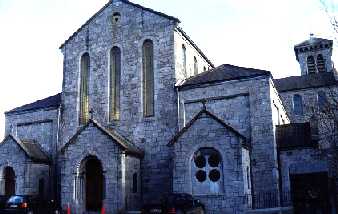
© St Michael's church
Rev. Thady Lynch P.P. built a church
on this site between 1779 (when the foundation stone was laid) and 1781
when the church was opened on 29 September 1781. There is a stone in
memory of Fr. Lynch in the south transept. The Arthur family owned the
land on which the church was built and would not allow any houses to
be built on the site. In 1881 this church was rebuilt under the supervision
of Mr M. Morris and cost £7,400. During the building of this new
church human remains were found, which are believed to have belonged
to the defenders of the city in 1690 during the siege of Limerick. The
remains were re-interred under the altar to the Sacred Heart in 1881.
While the church was being built, mass was said in the Town Hall from
the summer of 1881 until Christmas Day 1882.

© Plaque erected at Denmark Street to
commemorate the rebuilding of the church in 1881
When the church was built, the landscape
of the city was vastly different to the present day as open fields surrounded
St. Michael's church. The church is situated at the bottom of Chapel
Lane but the entrance to the church is from Denmark St. The church was
further enlarged in 1805. It is an Italianate church with Romanesque
features.

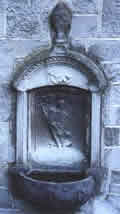
© Holy water fonts of St Christopher and Archangel Michael
A church bell was acquired and was first
used in the church on January 1st 1815. One of the two Holy Water fonts
at the side entrance shows the Archangel Michael slaying the Dragon
while the other shows St. Christopher fording the river whilst holding
the infant Jesus. The bell tower is capped by a very striking gilt representation
of Satan being vanquished by the Archangel, St. Michael.
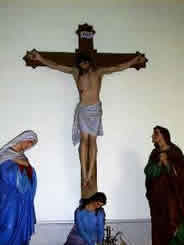

© Crucifixion scene and Pieta
As you walk into the church, there is
a monument to the Crucifixion of Our Lord while to the left of this
monument there is another statue of the Pieta. On the far wall on the
church there is a small statue of Mary teaching Jesus to read. The stained
glass windows in the church are plain.
As you walk up the left-hand aisle of the church, there
is a scaled model of St Michael's church.
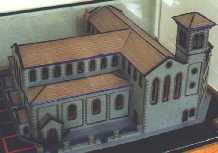
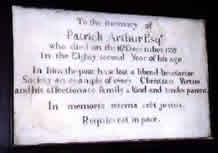
© Model of St Michael's church and Plaque to Patrick Arthur
There are two large plaques in the church and both are
situated in the left transept. The first plaque, which cost £300,
is to the memory of Fr. Patrick Hogan. It was commissioned after his
death in 1838. In Fr Hogan's will he left £2,000 to the Park College,
which was used to build St. Munchin's College.
The second monument is to Patrick Arthur, and was erected
after his death in 1779. Prior to the church renovations in 1881, the
flagstone was over his grave in the centre of the church. The people
of the parish erected the monument at a cost of £300.
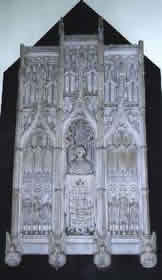
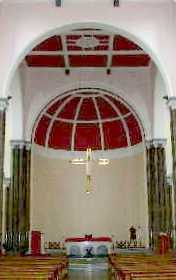
© Monument to Fr Hogan and Altar in St Michael's church
On the left of the main altar there is a shrine to Pope
Pius X. The baptismal font is also on this side of the altar. Over the
main altar there is a large crucifix. To the right of the main altar
is the tabernacle, which is on an altar donated by Mary O'Donovan and
her late husband Anthony. This altar depicts a scene from the Last Supper.
On the right hand side of the church, there is a print of the portrait
of Blessed Oliver Plunkett and a picture of the Mother of Perpetual
Succour.
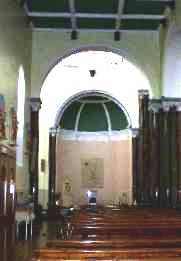
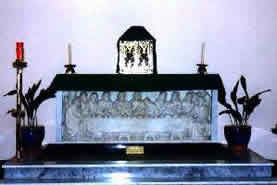
© Side Altars in St Michael's church
Fr. Hogan asked John Gubbins to paint the Crucifixion
over the Virgin Altar in the church. The inscription over the North
transept door dates from 1805 while the inscription over the south transept
door dates from 1779. The north transept was added in 1805.

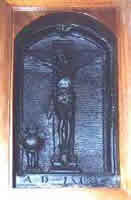
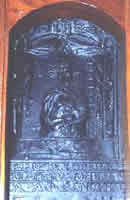
© Font stones in St Michael's sacristy
Many of the features in the original St. Michael's church
were sent to Raheen and Donaghmore chapels in 1881. The two side altars
in the church, the Sacred Heart and the Blessed Virgin Mary were both
removed. The High Altar, the altar rails and the church bell were sent
to Raheen chapel around this time too. In 1881 the three old font stones
were removed into the sacristy where they can be still seen to this
day. The three stones represent scenes from the Crucifixion and the
Last Supper along with a stone commemorating Fr. Patrick Hogan.
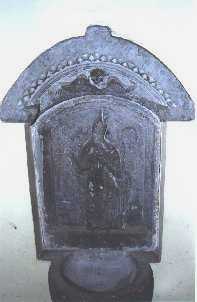
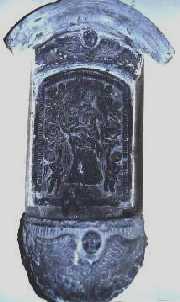
© Holy water fonts of the Madonna and Child
and of St Patrick
In the mortuary chapel there are two Holy Water fonts:
one of the Madonna and Child, the other of St. Patrick.
The tabernacle shows the Archangel Michael.


© Statues in St Michael's church
The interior of the church is today plain and simple but
in the past the church was referred to as the 'chapel of statues' due
to its large numbers of statues. Further renovations took place in St.
Michael's during 1967/68. Nearly all the statues have been removed in
the last 30 years. The high altar was similar to the altar in St. Joseph's
parish church and its present whereabouts is unknown. The high altar
stands on the site of the old sacristy from 1779. A side altar shows
a scene from the Last Supper and may have once been part of the old
high altar.
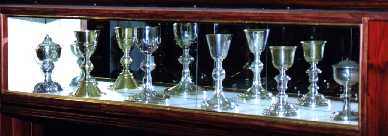
© The chalices and ciboria of St Michael's
Extensive records dating back to the establishment of
the church are kept in the sacristy of the church. There also exists
in the sacristy an extensive collection of chalices and ciboria, which
were donated by parishioners over the centuries.
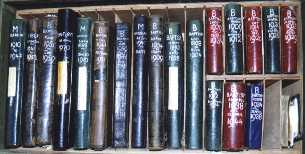
© Record Books in St Michael's
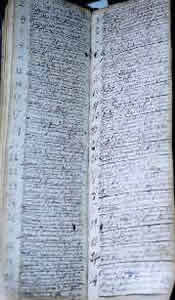

© Record Books in St Michael's and only surviving feature from
original church
This feature of the main altar is the only believed link
from the original church in 1779 through the renovations in 1805, 1881
and 1967/68 right through to the present day.
Before that, there was a church to St. Michael the Archangel
was built on an island where the Abbey River spread out above Baal's
Bridge. From old maps and drawings of Limerick City, this island was
situated between Englishtown and Irishtown. This area was outside the
city gate called West Watergate.
The church was probably originally built by the Normans
as they had a great devotion to St Michael. It was likely to have been
in the grounds of the graveyard that is now across the street from the
Granary building in Michael St.. This church was in ruins by early in
the seventeenth century and was totally dismantled prior to Cromwell's
siege of 1651.
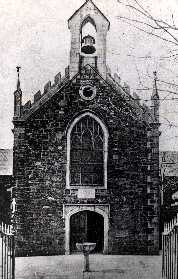
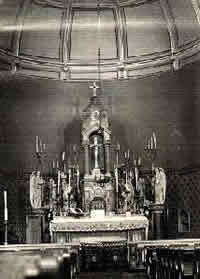
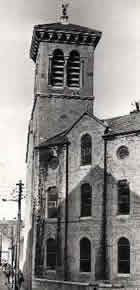
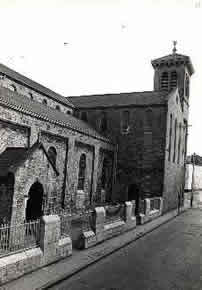
© A number of old photographs of St Michael's,
including one of the altar prior to restoration
Photographs courtesy of St Michael's Parish
The earliest mention of St. Michael's is in the Black
Book of Limerick in 1205. It was originally a prebandal but this ended
during the 13th century when it became part of the Archdeaconry of St.
Mary's Cathedral in 1418.
In 1735, Dr. Pierce Creagh arrived from Rome with a papal
bull for the Catholic Archdeaconship of the parish. However, as the
parish and its parishioners were so poor and could not support a priest,
Dr. Creagh did not take the parish.
From 1781 to around 1816, the priests lived in Robert
Street, which was next to the sacristy. The priests of the parish also
lived in Sexton Street House. Each house was home for two priests. Edward
Thomas O'Dwyer was a curate in the parish from c.1875 to 1886 and later
became the Bishop of the diocese from 1886 until his death in 1917.
Buried within the church are:
 Patrick Arthur (died 1779), Died 1779
Patrick Arthur (died 1779), Died 1779
 Dean Thady O'Flynn, Died 1813
Dean Thady O'Flynn, Died 1813
 Fr. Pat Hogan, Died 1839
Fr. Pat Hogan, Died 1839


Website by Lúnasa
Design